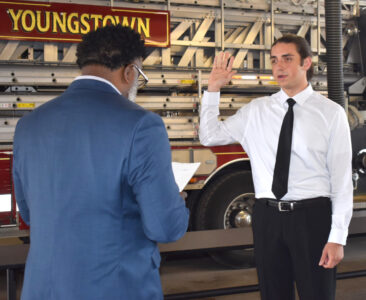Survivors share stories at Rally for Recovery

Correspondent photo / Sean Barron Bob Armstrong of Farmdale, who has struggled with alcohol addiction, looks at a memorial with the names of those who lost their battle with drug and other addictions. Armstrong was among approximately 900 people at Saturday’s 11th annual Rally for Recovery at Eastwood Field in Niles, which is sponsored by the Alliance for Substance Abuse Prevention.
NILES — Within the last decade, Justin Larson’s life trajectory has taken him from living alone in a truck in a parking lot to celebrating the ninth anniversary of his sobriety last week.
“I grew up in the country and was shy. I fell in love with drugs and alcohol that took away a lot of my fears,” Larson, 41, of Howland, remembered. “Alcohol was my best friend.”
Larson, who works as a peer-recovery supporter for Thrive Peer Support, shared part of the story of his struggles during Saturday’s 11th annual Alliance for Substance Abuse Prevention’s Rally for Recovery gathering at Eastwood Field.
Hosting the rally was the Trumbull County Mental Health and Recovery Board, of which ASAP is a project and coalition that engages in strategic partnerships to work toward solving the community’s substance abuse problems.
An estimated 900 people from Trumbull, Mahoning and Columbiana counties and elsewhere gathered to celebrate progress they’ve made in the recovery process, as well as to remember and honor those who lost their battles with addiction.
Larson, who suffered from depression beginning at age 8, lived all over the East Coast and, for a while, in his truck in a Myrtle Beach, South Carolina, Walmart parking lot. It was “a miserable existence” that also consisted of being charged with driving under the influence, but his mother, Donna York-Zoga, and other family members proved instrumental in helping Larson get back on his feet, he explained.
In 2014, he sought help at the Neil Kennedy Recovery Center “and never looked back.” Larson added that he also spent three years in foster living in Warren. The early stages of his recovery were frightening, but Larson had reached the point where he realized the alternative was worse.
“Recovery was scary at first, but whatever was in front of me was better than what was behind me,” he said.
“I pretty much abused every substance known to man,” Robert Day, 39, of Warren, recalled.
He also suffered the death of his 14-year-old son, who was struck by a train, along with separation from his wife. Nevertheless, Day, the father of three children ages 8, 9 and 12, has been clean more than five years — a situation borne out of a desire to do right by himself and his children, he explained.
“It’s been hard to live life on life’s terms, sometimes,” Day said, adding that he enjoys “a healthy and prosperous relationship” with his three children.
Day, who works for Wholesale Tire Co. in Warren, also is grateful to have a supportive and compassionate boss, he continued.
The father of three advised those suffering from an addiction to start on the recovery trail by taking responsibility for their past and accepting their mistakes as growing experiences, then find a sober support group, join a 12-step program and have a reliable sponsor.
“If I can find my way out, they can find their way out. The prettiest flowers start from darkness,” he continued.
Numerous agencies that included Compass Family and Community Services, Help Network of Northeast Ohio, Aspire Trumbull County, the Bluffs Addiction Campuses, Celebrate Recovery, Coleman Health Services, Meridian Healthcare, the Warren City Health District, New Day Recovery and Rise Recovery provided a slew of information and resources. Also available were pamphlets on problem gambling.
The majority of Ohioans are responsible gamblers, but perhaps 10 percent of those who gamble are considered at-risk. Of that figure, an estimated 0.9 percent of them have an addiction, Stephanie Geer, Meridian’s problem gambling program coordinator, noted.
Responsible gamblers know how to set time and money limits while not allowing their pursuit to negatively impact relationships with others. On the other hand, those with addictions often spend money otherwise earmarked for essential needs such as paying monthly bills, Geer explained.
Other warning signs include chronically borrowing money, lying or hiding information about money spent and growing problems with work and personal relationships, she noted.
An uptick in problem gambling has been seen with the recent legalization in Ohio of sports betting, which also can be done much faster online. That’s largely attributable to the three A’s: availability, acceptability and accessibility, Geer continued.
Saturday’s event also had a recovery walk around the Eastwood Field parking lot in which participants rallied around one another, as well as a scavenger hunt.
In addition, April J. Caraway, the Trumbull County Mental Health and Recovery Board’s executive director, read aloud the names of nearly 200 people from the tri-county area who lost their battle with addiction.
They included Amanda Tenney, who died 12 years ago from an overdose. Honoring her at Saturday’s Rally for Recovery were her sister-in-law, Danielle Tenney of Lordstown, who came with her mother, Shelly Roberts of Niles; Tenney’s children, Jay, 1, and Gianna, 4, and her niece, Lillian Gregg, 6, of Warren.
Tenney was saddened by the loss of her sister-in-law, but also was celebrating her husband, Jason Tenney, who has been clean for 12 years.
The main driving forces behind much of the problem are addictions to opioids — largely brought about by false and misleading information about them — and the proliferation of fentanyl, Caraway said.
“People are getting addicted to pain meds. It’s always the No. 1 cause,” she added.
news@vindy.com




